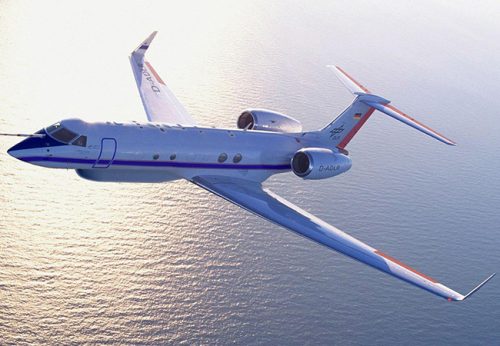In the first days of January, the HALO research aircraft will take off on the third part of the large-scale CAFÉ series of expeditions investigating oxidation processes in the atmosphere. CAFE stands for „Chemistry of the Atmosphere: Field Experiment.“ The CAFE-PACIFIC project has now been launched to perform measurements over the tropical Pacific region near Indonesia and northern Australia, the region of the Earth where convection, i.e. the vertical transport of air and thus of clouds and water vapor, is most intense.

The CAFE-PACIFIC mission, coordinated by the Max Planck Institute for Chemistry and Goethe University Frankfurt, investigates photochemical processes and aerosol formation in the tropical troposphere using the high-altitude aircraft HALO (High Altitude and Long Range Research A). The research aircraft has been equipped with highly sensitive mass spectrometric and optical instruments. The project team also includes researchers from the Karlsruhe Institute of Technology (KIT), Forschungszentrum Jülich (FZJ), the Leibniz Institute for Tropospheric Research (TROPOS), and the German Aerospace Center (DLR), which is also the operator of the HALO measurement aircraft. The scientists will use the measuring instruments to characterize atmospheric oxidation mechanisms and record the formation and growth of aerosol particles in the upper troposphere. These tasks will involve measuring a large variety of gaseous chemical compounds such as sulfur and nitrogen oxides, volatile organic compounds (VOCs), carbon monoxide, and hydroxyl radicals, as well as the number, size, and composition of aerosol particles.
The science team is planning research flights with a total of around 120 flight hours by the end of February, which means 15 take-offs and landings from Cairns Airport. Flights are also planned at dawn and dusk, as well as at night. During each flight, four researchers will be on board to monitor the 15 different measuring instruments and maintain contact with their colleagues on the ground. The return flight of the measurement aircraft to Oberpfaffenhofen is scheduled for February 28, 2024.
The participation of Goethe University is funded by the priority program „HALO“ (SPP 1294) of the German Research Foundation (DFG) and by the DFG-SFB/Transregio TRR 301 „The Tropopause Region in a Changing Atmosphere“.
The three CAFE expeditions
CAFE-AFRICA, the first of the three research expeditions, took place in summer 2018. The aim of the expedition was to investigate the influence of emissions from biomass combustion in Africa on the atmosphere over the tropical and subtropical Atlantic. More.
The second expedition, CAFE-BRAZIL, took place in December 2022 and January 2023 over the Amazon region. The researchers spent 60 days collecting data on the chemical processes in the largely clean atmosphere above the Amazon rainforest in Brazil. More here and here.
The third and final project in the series is CAFE-PACIFIC. It concentrates on the region around Indonesia and northern Australia, and the Indo-Pacific Warm Pool. As a result of the high water temperatures that prevail here, the high-reaching cloud convection in this region is the strongest in the world. This in turn causes strong heat transportation from the surface of the sea into the tropopause region (approx. 12 – 16 km), which is why the Indo-Pacific Warm Pool is sometimes referred to as the Earth’s heat engine. In contrast to the Amazon region, where rainforest emissions dominate the chemical processes in the atmosphere, the researchers expect the dominant influence of unpolluted maritime air over the tropical Pacific. The comparison between the effects of convection over the Amazon (green ocean) and over the Indo-Pacific Warm Pool (blue ocean) will contribute to a better understanding of atmospheric processes.
More.
Aim of the CAFE research expeditions
„In the course of the CAFE missions, we have collected data under pristine conditions in the Amazon region and in regions where a lot of biomass is burned. We will compare and combine these results with the data that we will now measure over the Pacific. We expect to gain fundamental insights into natural tropospheric chemistry and aerosol processes in terrestrial and marine environments in the tropics,“ explains Jos Lelieveld, Director of the Atmospheric Chemistry Department at the Max Planck Institute for Chemistry and coordinator of the CAFE-PACIFIC research trip.
All measurements also serve as the basis for computer models that depict the chemical processes and atmospheric feedback mechanisms of the Earth system and that are intended to predict future climate developments.
About HALO
The research aircraft HALO (High Altitude and Long Range Research Aircraft) is a joint initiative of German environmental and climate research institutions. HALO is funded by grants from the Federal Ministry of Education and Research (BMBF), the German Research Foundation (DFG), the Helmholtz Association, the Max Planck Society (MPG), the Leibniz Association, the Free State of Bavaria, the Karlsruhe Institute of Technology (KIT), Forschungszentrum Jülich (FZJ) and DLR. DLR is both the owner and operator of the aircraft.
General information: The troposphere 0 – approx. 16 km: The troposphere is the lowest layer of the atmosphere and extends up to a height of around 16 km in the tropics and up to 8 km at the poles. As the troposphere contains almost all the water in our atmosphere, it is here that our daily weather with all its facets and clouds is played out. The driving force behind our weather is the varying intensity of solar radiation, which heats Earth’s surface. As warm air rises and cold air sinks, the troposphere is mixed by vertical flows (convection). Its name is thus derived from the ancient Greek word „trope“ (turn, change). In the troposphere, the temperature decreases with altitude by an average of 6.5 K/1 km and reaches values below -50°C at its upper limit, the tropopause.









